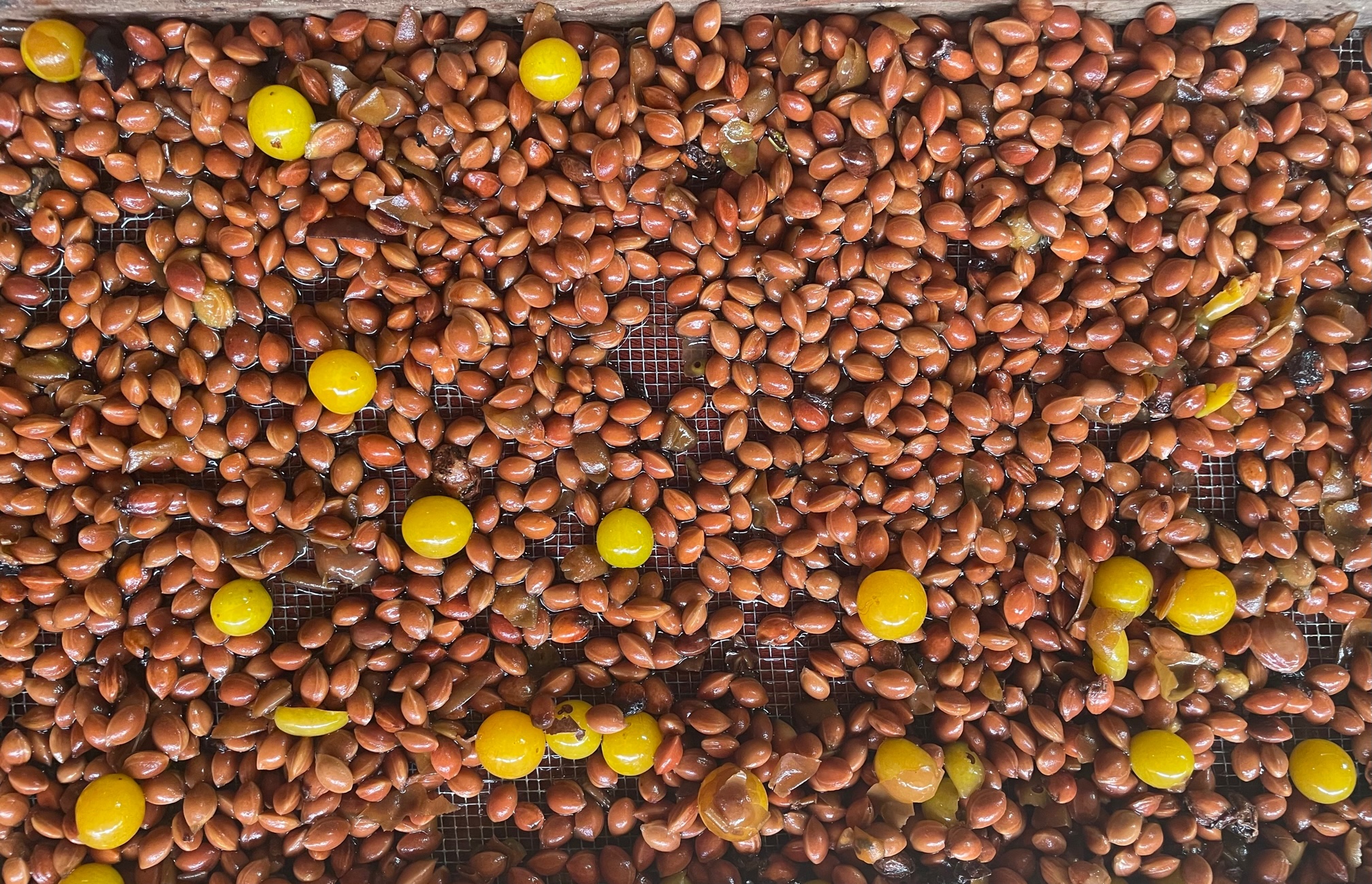


Mirabelle plum is a wild French plum grown worldwide for its rich complex flavor used in jam and other processed fruit mixtures including pies, preserves and wine. The name translates as 'wonderous beauty'. Although commercial uses are centered around the French region of Lorraine, it is also found in Poland and the Czech republic where this plum was carried by cultures who found it as a wild population of alpine plums. Today large trees exist in the U.K. in some very out of the way places. It has been distributed by pits much like the peach was from China. According to recent genetic analysis, it appears it has its origins in Anatolia or eastern Turkey and was distributed from there. Large populations of Prunus are naturally moved by humans often times a little at a time as people discover the food value and delicious nature of their discovery.
If you Google this plum, you will first notice it is labeled as the illegal plum. It is illegal to import the seeds, fruit and plants just like all the Prunus species. However, it can be grown within the U.S. from U.S. sources. It is currently grown from a few nurseries where named selections have been created. Cornell University released a variety. The true mirabelles are much like basmati rice where the climate and soil help create the perfect flavor profile for this rather rare alpine species. Having a large commercial orchard of them may require a new name outside of the words 'Mirabelle."
My Mirabelle plums like all the plums I grow at my farm were started from seeds and have been producing now for 30 years. From seed it takes roughly 8-10 years to fruit. Once the trees reach 2 inches in caliper the trees will begin to produce fruit spurs and then flowers. Mirabelle plums are slow growing at first. They are considered a species cultivar or subspecies syriaca. My plants tend to be more like a crabapple tree in shape with asymmetrical branching. The fruit is similar to beach plum in size with colors of red and yellow. Most of the super productive trees appear to be yellow which is more true to type from seed. Red fruited plants have slightly larger fruits. The subspecies syriaca is completely immune to black knot and has few insect pests or fungal diseases. There appears to be some damage by plum curculio on some trees but it is not every year and most years the fruit is clean without spray.
Older trees will begin to loose the larger limbs after 25 years and new sprouts near the trunk should be kept to take the place of the main trunk which will eventually die back to the root crown. Other suckers can be trained to maintain the root system. The tree itself is not particularly fast growing but in the right sandy soils with good drainage the trees respond to fertilizer very well and branches can be laden with fruit in good years. Trees are often twiggy compared to other plums with multiple branches forming even on young trees. Much like hickory, once the tap root is established the tree is vigorous and fruitful.
This species plum should be planted because of its unique flavor profile and its ability to grow in the poorest of soils. The flavor is unique in the plum world. No wonder it was carried in the pockets of so many people far beyond its historical native range. Further selections could be made based on yield.
To germinate the seeds: Mirabelle plums are usually doubly dormant and require two cold periods to sprout fully. A few seeds will spout after the first dormancy. Store the seed in a lightly moist media in the refrigerator for 60-90 days at 33F to 38F. Some seeds will split after 60 days and can be plucked out and planted. Lightly cover the seeds with 1/4 inch soil or sand. Letting the seeds go in the refrigerator for a full 90-120 days is ideal and may cause more sprouting to occur. After harvest I let the seeds rest throughout the summer prior to refrigeration. This helps with the embryo formation. You can also plant them in a closed flat outside to simulate the natural cycle of cold and warm. Like all Prunus species, mirabelle is easy to grow from seed and you get close to a 100 percent germination as the seedlings do not suffer from phytophora.
Seeds from 2023 crop year. Refrigerated at 38-42F.
| Plant Specs |
| Genus & Species |
Prunus insititia subspecies syriaca |
| Seed Source |
Michigan. Ecos selection with no problems with black knot. Grown originally from an arboretum collection. French,Czech, or UK origin. |
| Hardiness |
-25F or more. |
| Height (ft) |
10-20 |
| Width (ft) |
10-15 |
| Pollination Requirements |
Self fertile, but two will increase fruit yields |
| Soil |
Grows very well on dry rocky soil with little top soil. |
| Climate |
Zone 4-8 An alpine tree. Adaptable in other areas including the U.S. and U.K. Tends to grow best in cooler climates. |
| Ease of Cultivation |
Yields are good producing fruit all along the branches. Trees are shrubby with an asymmetrical structure. It is important to let the suckers go on this species as they replace the branches that fade after years of fruiting. This selection I have at my farm is completely immune to black knot. There is little curculio damage. Some trees have none. The larger branches begin to shed after 20 years. Very practical plum species to grow from seed. The yields are high. Use gypsum and high nitrogen fertilizer to invigorate the tree ever few years. It seems to help with higher fruit set. |

